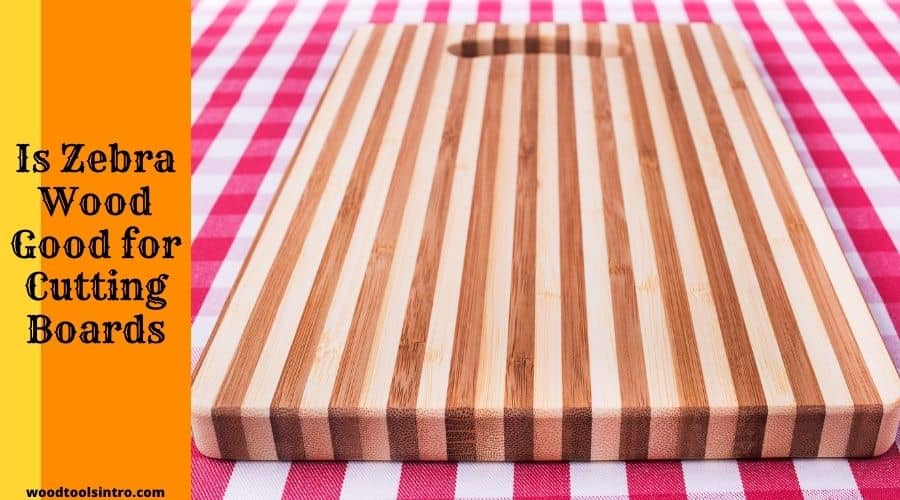Have you ever heard of zebra wood used for cutting boards?
I know most of you didn’t. But once I get to know about the characteristics and look of this beautiful exotic wood, I have been eagerly waiting to use it to build my cutting boards.
Originating exclusively from the African region, especially Cameroon and Gabon, zebrawood is well-known for its use in various sectors. However, does that also make zebrawood a good option for building cutting boards?
In today’s article, I’ll discuss different aspects of Zebrawood to determine whether it’s eligible to be used as a cutting board material.
So, without further ado, let’s begin.

Read blog on
Can Zebra Wood be used for a cutting board?
Though zebrawood looks excellent in any woodworking project, woodworkers have questioned whether they can use it for cutting boards. Now, the answer to this question is a bit tricky.
We often see cutting boards made from a single type of wood. Then there is another type, where you can incorporate secondary wood into the primary material to uplift the cutting board’s durability or look.
If you plan to make the cutting board entirely from zebrawood, that might not be a great idea. Though zebrawood is known for its high durability, extensive cutting jobs might prove to be challenging.
However, you should go for it if you plan to make the board by incorporating zebrawood with a primary wood option like maple, walnut or beech.
Why use Zebrawood for Cutting Board?
You cannot use zebrawood entirely for the build of your cutting board. But if it’s only about the look, you can definitely bring that aspect to your cutting board by adding a few stripes of zebrawood. Here are a few reasons why you should use zebrawood for cutting boards.
- Zebrawood is beautiful. So, it’ll add a stylish look to your cutting board.
- Zebrawood is pretty dense (specific gravity of 0.70) to be used as a secondary cutting board wood.
- Durability is an essential aspect of any cutting board wood, and zebrawood has that.
Is Zebrawood Toxic?
Food safety is a prime concern when choosing wood for cutting boards. From my experience with cutting boards, I have noticed that many exotic/ tropical foods are not considered food safe. So, it’s completely normal if you have thought about whether zebrawood is toxic.
While there is no conclusive evidence against zebrawood being toxic, it’s best to avoid it as the primary material of a cutting board. Moreover, zebrawood is a thoroughly proven sensitizer resulting in eye and skin irritation.
Some people can even have an allergic reaction to zebrawood too. Before deciding to use zebrawood for the cutting board, ensure you won’t have any health issues from it.
Is Zebrawood Waterproof?
Waterproofing is an essential consideration for any cutting board wood. In that regard, you don’t have to worry as zebrawood is entirely waterproof. However, like any type of wood, zebrawood also soaks water that can ruin your cutting board over time. The porous surface quickly absorbs water and can destroy the surface of your cutting board over time.
In that case, you have to follow some precautionary measures to ensure it doesn’t happen with your board. For example, while cleaning the cutting board, don’t soak it into the water thoroughly or put it inside the dishwasher to allow water to soak in.
Besides, food-grade mineral oil seasoning and routinely reapplication can keep your zebrawood cutting board waterproof as long as you want. Food-grade mineral oil is ideal because there is no odour or taste to affect your cutting board.
What does Zebrawood smell like?
I guess the smell of zebrawood is another reason you shouldn’t build a cutting board entirely from zebrawood. This distinctive foul smell is a way of identifying real zebrawood.
Though this distinct smell fades away after drying, you can still occasionally get the smell. This smell can easily get into your food if your cutting board is made entirely of zebrawood.
Many people describe this smell in different ways. Some say it smells like a barnyard, while most describe it as a petting zoo smell. Whichever the case is, you might need to work with a respirator to work through the unpleasant smell of zebrawood while working.
Is zebra wood safe for cutting boards?
The answer is somewhat the same as before. If you are using zebrawood partially for your cutting board, only for decorative purposes, then it’s completely safe to use a few stripes of zebrawood. However, complications may arise when you try to build a board entirely made of zebrawood.
The durability can be a concern when you try to work with something super heavy, like chopping pork meat. Besides the issues mentioned above, the foul smell, allergic reaction, and sensitization indicate that zebrawood is not safe for cutting boards.
Last Word
Here we are at the end of my article. I hope my writing has answered all your questions in mind regarding the use of the zebrawood for a fine unit of zebrawood cutting board.
As you have seen above, it’s not a great idea to use a cutting board entirely made out of zebrawood. The only way you can use zebrawood with a cutting board is by pairing it with a regular cutting board wood.
In this case, you have to consider the cost here. Zebrawood is pretty expensive too, partly for the reason of exclusive origin from Africa. So, you have to decide whether it’s worth it to spend a fortune on a cutting board.
Also, zebra wood has been listed as a vulnerable tree since its production has been lessened by a massive 20% in the last three generations.
So, on the whole, you might want to reconsider your decision of using zebra wood from your cutting board. And, if you have made up your mind, that’s okay too. Nothing is stopping you from adding the beautiful stripes of zebrawood on your cutting board

I am Imtiaj Islam. I am a wood working enthusiast, having 6 years of experience in carpentry work. I have a BBA graduate degree from Chittagong College. I got vocational training on wood works from Korean Polytechnic out of the quest and zest he has for carpentry as well. I take several wood projects and keep testing different woodworking tools for comfortable and perfect work. I just love playing with woods and machines.
